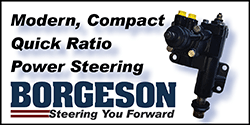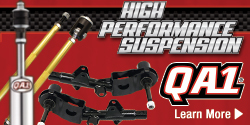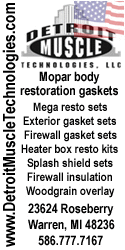You are using an out of date browser. It may not display this or other websites correctly.
You should upgrade or use an alternative browser.
You should upgrade or use an alternative browser.
HEI current limiting
- Thread starter Geoff 2
- Start date
Canadian1968
Well-Known Member
Great.
DID you notice that your own information actually says not to use a coil lower than .5 ohms?
It actually suggest that at the very lowest point. It's specifically says .5 - 1.0. It definitely does not suggest running 0.3 ohm coil. And again, your own information says lower resistance causes more heat.
So the resistance of the coil IS directly related to the heat thar is generated by moduel.
He is using a coil with even lower resistance than what is suggested. Its also desinged for CD ignition, i know your article only touches on primary resiatance but would u not agree that is going to create more heat than it should ?
DID you notice that your own information actually says not to use a coil lower than .5 ohms?
It actually suggest that at the very lowest point. It's specifically says .5 - 1.0. It definitely does not suggest running 0.3 ohm coil. And again, your own information says lower resistance causes more heat.
So the resistance of the coil IS directly related to the heat thar is generated by moduel.
He is using a coil with even lower resistance than what is suggested. Its also desinged for CD ignition, i know your article only touches on primary resiatance but would u not agree that is going to create more heat than it should ?
Canadian1968
Well-Known Member
Basically, what your saying isn't wrong. Yes the HEI module may have a limiting device , and adaptive dwell BUT when your paring it with a coil that is trying to charge itself so fast ( because it actually designed to give multiple smaller burst not one large one ) Your making the HEI module limit itself all the time . Your making it work harder than it should . You have a coil that's designed for multiple super fast, high energy burst and you are paring it with a module that is ment to fire one single high burst . The module is basically saying SLOW the F'down ! and its working really hard to do that, and in turn creating A LOT of heat.
Uh-OH- I think I hear Bob waking up from his nap-
Don67Satellite
Well-Known Member
- Local time
- 7:59 AM
- Joined
- Dec 16, 2021
- Messages
- 1,308
- Reaction score
- 2,110
- Location
- Abbotsford, British Columbia, Canada
Uh-OH- I think I hear Bob waking up from his nap-

Geoff 2
Well-Known Member
Quite agree that the lower res coil is causing more heat.....buuuuuut... the heat sink is very thin & flimsy. With a heat sink with a greater volume of metal in it, the module would be cooler.
The heat sink pad on the HEI dist is about 3/16" thick [ I have measured it ].....which looks about twice the thickness of Zombe's heat sink.......plus of course the heat in the HEI pad can dissipate into the surrounding HEI body.
The MSD HEI replacement coil has a 0.31 ohm pri res.....
The heat sink pad on the HEI dist is about 3/16" thick [ I have measured it ].....which looks about twice the thickness of Zombe's heat sink.......plus of course the heat in the HEI pad can dissipate into the surrounding HEI body.
The MSD HEI replacement coil has a 0.31 ohm pri res.....
Canadian1968
Well-Known Member
Perfect.
You are referring to the GM heat sink that he was using ? I have to point out... made specially for the GM module . I have not seen one in person but scale in this picture I would put at roughly 1/8" thick , add the surface area of the fins as well. Don't forget he is bolting this ON TOP of my piece that I provided which is ALSO 1/8". I'm sorry but that is a ton of heat disappation ! Isolated from the other parts of the engine and in open air.

Now here what really matters ....

The flamethrower lll coil, has 110:1 turn ratio, your provided coils are 70 - 85 range . Also you can see the relation between turn ratio and inductance ( if provided) your lowest is 3.5 the highest is 7! .
The flamethrower is 2.5 . It is made specifically to charge itself as fast it can . And is going to charge faster then any of those coils you provided EVEN though their resistance is the same. It's going to be activating the current limiting and dwell in the moduel , constantly. The moduel never really has a time "rest" and will just burn itself out. I don't care how big the heat sink is ..
You are referring to the GM heat sink that he was using ? I have to point out... made specially for the GM module . I have not seen one in person but scale in this picture I would put at roughly 1/8" thick , add the surface area of the fins as well. Don't forget he is bolting this ON TOP of my piece that I provided which is ALSO 1/8". I'm sorry but that is a ton of heat disappation ! Isolated from the other parts of the engine and in open air.
Now here what really matters ....
The flamethrower lll coil, has 110:1 turn ratio, your provided coils are 70 - 85 range . Also you can see the relation between turn ratio and inductance ( if provided) your lowest is 3.5 the highest is 7! .
The flamethrower is 2.5 . It is made specifically to charge itself as fast it can . And is going to charge faster then any of those coils you provided EVEN though their resistance is the same. It's going to be activating the current limiting and dwell in the moduel , constantly. The moduel never really has a time "rest" and will just burn itself out. I don't care how big the heat sink is ..
So is the module inside that plastic housing? Having trouble seeing how that little heat sink is helping. From the picture it appears it would create a cool spot in the middle and the outer areas will be hotter RE uneven internal temperature.
Also I am inclined to believe that the specs for GM coil designed for a GM module should work the best.
Also I am inclined to believe that the specs for GM coil designed for a GM module should work the best.
Canadian1968
Well-Known Member
So is the module inside that plastic housing? Having trouble seeing how that little heat sink is helping. From the picture it appears it would create a cool spot in the middle and the outer areas will be hotter RE uneven internal temperature.
Also I am inclined to believe that the specs for GM coil designed for a GM module should work the best.
Are you referring to my 3d printed piece ? The hei module bolts to it and is left in the open. The heats sink is a solid piece of 1/8th aluminum. After talking with zomebzoo, I have purchased some additional heat sinks to add to my design . Although I belive when the correct coil is paired with module the original design is sufficient. But if I can add additional why not.
The material it's printed in is a poor conductor of heat itself. The aluminum is the heat conductor and will pull the heat from the module and then disappate into the surround open air. The heat sink will get hot , that's what's its supposed to do.
Even as I am cutting the pieces with a hand saw, the piece of aluminum gets pretty warm .That's just from the friction created from the saw. The aluminum conducts the heat that well! .It's actually pretty impressive.
If your 3D part does not conduct heat, then where does the heat go? That small piece of aluminum is sandwiched between a generator of heat and a non conductor of heat. It is essentially doing nothing.
Canadian1968
Well-Known Member
It's completely open on the back side and the case is vented.
It's not sandwich between anything. Its completely open to the air and allow the heat to disappate as much as possible .
As with any heat sink. The job is to pull the heat from its source, and basically bleed off into the air. Doesn't matter how big the heat sink is same rules apply.
I do agree, that my first basic design will benefit from the addition of the other finned heat sinks I have added.
It's not sandwich between anything. Its completely open to the air and allow the heat to disappate as much as possible .
As with any heat sink. The job is to pull the heat from its source, and basically bleed off into the air. Doesn't matter how big the heat sink is same rules apply.
I do agree, that my first basic design will benefit from the addition of the other finned heat sinks I have added.
Similar threads
- Replies
- 49
- Views
- 6K
- Replies
- 128
- Views
- 15K
- Replies
- 6
- Views
- 1K















